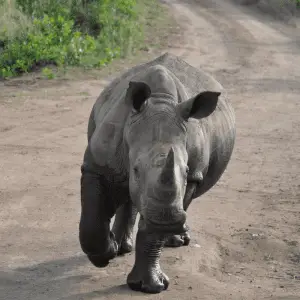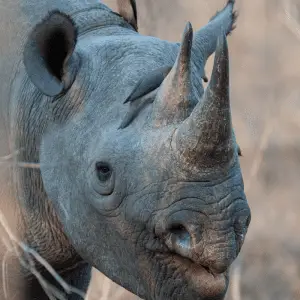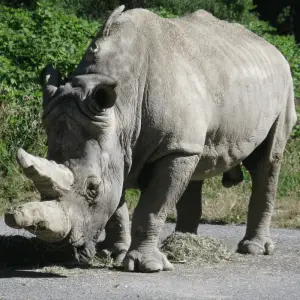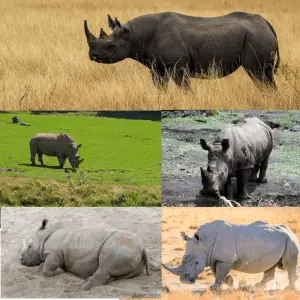We all know that animals have some pretty extraordinary senses. For example, dogs can smell things from really far away, and bats can navigate through the darkness using their echolocation. But what about rhinos? Can they see potential threats in their environment before they become a problem? Or are rhinos blind? Let’s take a closer look at this question and find out!
Rhinos are not blind. However, rhinos have poor eyesight and cannot see any object a few feet away from them within an open space. Apart from having poor vision, rhinos are also colour-blind.
Now we know that rhinos are not blind. Let’s learn about their vision and other senses in more detail.
Rhino’s Vision
Rhinos certainly have poor vision, and one of the reasons is the position of their eyes which also limits their vision even further.
Rhinos can’t make any visual communication with other animals or humans, but instead, they make full use of their other senses. Such as the sense of sound and smell.
All of the five rhino species suffer from short-sightedness.
Another problem due to their poor vision is that they are quick to charge people or other animals. Especially whenever they detect any unusual scent.
Rhinos mainly use their sense of smell and sound to know if any threat is approaching them.
Charging is one of the reasons why rhinos are considered so dangerous. As rhinos can’t see correctly, they can’t decide whether the animal or human is a threat to them very promptly. As a result, their natural tendency is to charge them before confirming if they are a real threat or not.
How far can a rhino see?
There are no official reports on how far a rhino can see, but sight strength is that a rhino won’t be able to distinguish between a tree and a man if they are 20 meters away. Many official reports show that when the 20-metre distance increases to 100 or 200 metres, a rhino won’t be able to detect the presence of human beings, animals or even their movement.
Why do rhinos have poor vision?
There are a few reasons behind the poor vision of rhinos. Some believe that the massive structure of the animals is the reason for their poor eyesight, whereas others believe that rhinos have evolved in that manner only. Also, many believe that eyeball size is their poor eyesight.
To know more about the reasons for the poor eyesight of rhinos, follow the remainder of this post.
Eye Size
There are five species of rhinoceros in this world. However, all these rhino species have small eyes compared to their massive body size. The eyeball is always reciprocal to the animal’s body size in mammals. Eye size means if the animal is smaller, it would have bigger eyes.
In this regard, the Sumatran rhino’s eyes are tiny compared to its head and body.
Binocular Vision
The location of the rhino’s eyes is on the opposite side of its head. Rhinos don’t have the advantage of binocular vision like other mammals on Earth and human beings. On top of that, they are also colour-blind.
Inbreeding
Another reason behind rhinos having bad eyesight is inbreeding. Inbreeding causes genetic defects and even infertility. It can also result in defective organ formation in the following generations. Also, inbreeding results in poor eyesight, unexpected behaviour, and skin cancer. However, inbreeding became necessary to prevent the extinction of certain rhino species in the wild.
Recommended Read: How often do rhinos give birth?
Evolution
The massive size of the rhinos resulted in poor eyesight. Naturally, vital eyesight was never a strong need, and other senses took preference, such as the sense of smell.
Recommended Read: Ancestors of the Rhino
Can rhinos sharpen their vision?
Rinos may be able to sharpen their focus by closing one eye or squinting. However, there is no definite proof. While walking or combatting, a rhino might try to focus with one eye.
Other Senses to Compensate Poor Eyesight
Rhinos have strong senses of smell and hearing to compensate for their poor eyesight. The most important part of a rhino’s brain is the olfactory organ dedicated to smell. Having a sizeable olfactory organ indicates how important the sense of smell is for the rhino to survive in the wild.
Sense of Sound
The sense of sound is also essential for rhinos in the wild. They need to rely on their ears as they suffer from bad eyesight. It won’t be wrong to say that rhinos have excellent hearing senses. Hence, they can easily hear any threat from many meters away.
The rhinos have cup-shaped ears that can rotate in any direction. The cup-shaped ears allow a rhino to pick up sounds from any place at 360 degrees angle. Their unique ear shape helps the sound waves easily reach the rhinos’ inner ear without any intervention.
The ears of the rhino can easily pick up infrasound. A rhino can easily take some action when it hears any distressing calls from birds or other animals.
Sense of Smell
The sense of smell can assist the rhinos in identifying objects at a distance they can’t see or hear. Their sense of smell has likewise intensely evolved to compensate for their short-sightedness. The most extensive area of the cerebrum of this mammal assists with recognising different sorts of smells.
Among all other warm-blooded animals, the sensation of smell is excellent in a rhinoceros. Their nose is loaded up with coin-moulded patches containing many sensory cells.
Recommended Read: Why do rhinos have horns?
Touch
However, other senses, like the sense of touch or taste, are equally crucial for the rhino’s survival. Their sense of touch might be present in them; however, this sense doesn’t fundamentally affect their survival in the wild.
Taste
Rhinoceroses are herbivorous creatures and don’t rely upon their taste to eat any vegetation. Rather they smell the plant first to check whether it’s fresh or not and then eat it up.
If you are curious about what a rhino eats, I have written an article that discusses the different foods they consume.







